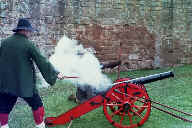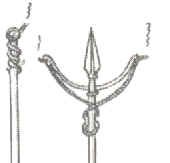
Cannon
The Cannon or Field-piece was the ultimate weapon of the 17th century army. It could quickly be brought into position and directed at stout buildings and defences to demolish stonework that had stood for centuries before.
Smaller cannon could be used against the enemy soldiers with equally devastating effect. The tremendous noise from a barrage of cannon could soon demoralise the enemy before the battle began.
The term 'cannon' strictly refers a muzzle-loading field firearm and not the carriage on which it may (or may not) have been mounted during battle.
Types of Cannon
There are a number of types of cannon, the names denoting the size of the weapon.
 The
Cannon Royal or Whole Cannon would have had a 7-inch calibre and be 11
feet long.
The
Cannon Royal or Whole Cannon would have had a 7-inch calibre and be 11
feet long.
The Demi-cannon was 6-inch calibre, though the same length and firing a 32-pound shot.
The Culverin was of smaller calibre relative to its length and therefore of greater range and can be sub-divided into:
1) The Culverin, typically would be 5-inch calibre, firing a 17-pound shot. Its length varied from 8 to 13-feet
2) The Demi-Culverin, a 9-pounder of 4 inch calibre, was up to 11 feet in length
3) The Saker, a 5-pounder of 3 inch calibre, was about 9 feet long
4) The Minion, a 4-pounder of 3 inch calibre which was also some 9 feet long
5) The Falcon and Falconet, which were 2 to 3-pounders and 1 to 2-pounders respectively.
![]() A
small brass cannon usually mounted on a light carriage
A
small brass cannon usually mounted on a light carriage
6) The Robin or Robinet were about the smallest cannon, firing up to a 1-pound ball.
7) The Mortar was a very short barrelled cannon, but of large bore. It was used to fire large hollow iron balls filled with powder as a high explosive charge. This charge also had a fuse, so care was needed to time the fuse to burn out by the moment of impact on walled defences.
8) The Petard was similar to a large bell with the wide end fastened to a wooden board. It was filled with powder and 'Sappers' would hang it on the gates of a stronghold and light the fuse, which led into a small vent at the top of the 'bell'. The resulting explosion would destroy the woodwork and the gates would fall.
The Gun-crew's tools
Most cannon or 'field-pieces' are mounted on a wooden wheeled carriage of the same design but scaled according to the size of the gun mounted.
The loading and firing is almost identical to that of the musket, though extra tools are required to clean-out the barrel after every shot. The gun-captain calls out the instructions during preparation and after 'giving-fire'.
Heavier cannon were used to demolish strong wall defences, firing iron or stone balls of the right calibre. Sometimes a number of smaller projectiles called 'grape-shot' or 'chain-shot' were used as anti-personnel missiles.
The tools required to work these cannon are made for each calibre and barrel length. Listed in order of use by members of the gun-crew there is
(1) The worm. This is a double spiral, like a corkscrew, fitted on the end of a wooden shaft to 'search' for debris and embers after firing, or to remove a charge that fails to go off after a couple of attempts with the priming powder.
(2) The wet-mop. This is a sponge, mounted on a shaft which is dipped into a pail of water to swab-out the barrel and douse any embers remaining after worming.
(3) The dry-mop. This looks the same as the wet-mop, to dry out the barrel. (Best not dipped in water!)
(4) The Powder-Scoop. This was used to place a measure of powder down the barrel, simply turn the shaft 180 degrees when it hits the bottom and withdraw it empty.
(5) The Ram-rod. as the name implies, this is used to ram the powder, the wadding and the ball until it is tightly compressed.
(6) Pricker. This is a piece of wire the gun-captain will use to clear the vent and to ensure the priming powder will meet the main charge of powder.
(7) Powder Flask. This is usually made of horn with a spout to pour the priming powder into the vent, the hole on the top of the barrel which leads to the main charge of powder. The gun-captain may cover the small mound of powder on the vent with his loose glove if the wind is strong. Then remove it just before the linstock is introduced to the powder.
 (8) Linstock. This
is a wooden pole with a small clamp to hold a length of smouldering slow-match. It
is stuck into the ground away from the cannon until the gun-captain uses
it to introduce the match to the vent, at the same time shouting 'Give
fire!'
(8) Linstock. This
is a wooden pole with a small clamp to hold a length of smouldering slow-match. It
is stuck into the ground away from the cannon until the gun-captain uses
it to introduce the match to the vent, at the same time shouting 'Give
fire!'
(9) Budge-barrel. This is the name given to the powder barrel which is kept away from sparks and the activities of the gun-crew. The top has a leather flap to keep out sparks.
(10) Water-pail. This is often a canvas bucket. Yes, these actually hold water when wet! It holds the water for the wet-mop and is a vital part of the cannon tools.
The gun-captain will also posses a measuring device like a protractor which he inserts into the muzzle to check the elevation. He will set the elevation according to a mathematical chart which gives recommended powder amounts and weight of shot for the given angle and distance the shot should reach.